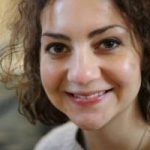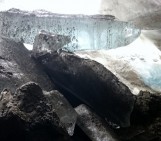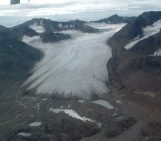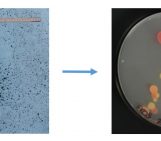
The interface between a glacier and its underlying bedrock is known as the subglacial zone. Here lie subglacial sediments, the product of mechanical crushing of the rock by the glacial ice. Despite their lack of sunlight, nutrients and oxygen, subglacial sediments host active and diverse communities of microorganisms.
What we (don’t) know about subglacial microorganisms
The past few decades have seen major advances in our understanding of these communities, including the role these microbes play in the chemical breakdown of underlying bedrock (chemical weathering reactions). It is now known, for example, that microorganisms in subglacial systems are involved in pyrite oxidation and it certainly seems that bedrock mineralogy influences the composition of these microbial communities.
However, most studies to date have focussed on the biogeochemical cycling of sulfur and nitrogen in these systems. Consequently, the microbial mediation of iron cycling in subglacial systems remains poorly understood, despite the importance of iron in ocean fertilisation and other downstream environments. For instance, phytoplankton in the open ocean are often limited by the amount of iron available, so fluxes of iron to the oceans from glaciers and ice sheets are an important contribution to ocean productivity.
A new study about subglacial iron
In a new paper published in Biogeosciences, we investigate microbial iron reduction in subglacial sediments. Microorganisms that carry out this metabolism are able to harness energy from the reduction of oxidised iron minerals (such as ferrihydrite and other iron oxides).
We wanted to know two things:
- are these microorganisms present and alive in subglacial sediment?
- are these microorganisms adapted to the cold conditions of these environments?
To achieve this, we set up experiments in which we ‘teased out’ the microorganisms that make a living from iron reduction, and measured their rates of iron reduction at two different temperatures: 4°C (blue line in the figure) and 15°C(red line). These temperatures were chosen since truly cold-loving (‘psychrophilic’) microorganisms grow optimally at temperatures below 10-15°C, whereas those that tolerate cold temperatures (‘psychrotolerant’) prefer to grow in higher temperatures.
Microorganisms that can use iron to make a living are amongst the most plausible life to exist on Mars
We found that active iron-reducing microorganisms were present in all of our subglacial sediment samples, which spanned glaciers in the High Arctic, European Alps and Antarctica, and that in almost all cases rates of iron reduction were higher at the lower temperature tested. To get an idea of which microorganisms were carrying out this process, we looked at the DNA from our experiments to identify the microbes present. We found that the microorganisms using iron in our experiments were largely the same, suggesting that the same key players are active in these types of environments worldwide. Overall our paper suggests that microbial iron reduction is widespread in subglacial environments, with implications for the availability of iron for other biogeochemical processes downstream. Subglacial environments are thought to be similar to potentially habitable environments on Mars, and microorganisms that can use iron to make a living are amongst the most plausible life to exist on the Red Planet, now and in the past. Our work therefore strengthens the hypothesis that similar environments beyond Earth could harbour this type of life.
Edited by Sophie Berger
 Sophie Nixon is a postdoctoral researcher in the Geomicrobiology group at the University of Manchester. She completed her PhD in Astrobiology in 2014 at the University of Edinburgh, the subject of which was the feasibility for microbial iron reduction on Mars. One essential task in the search for life on Mars and beyond is defining the limits of life in extreme environments here on Earth. It was during her PhD that this study was carried out in collaboration with researchers at the University of Bristol, where Sophie gained her MSci in Geographical Sciences. Sophie’s research interests since joining the University of Manchester are varied, spanning the microbiological implications of anthropogenic engineering of the subsurface (e.g. nuclear waste disposal, shale gas extraction), as well as life in extreme environments and the feasibility for life beyond Earth.
Sophie Nixon is a postdoctoral researcher in the Geomicrobiology group at the University of Manchester. She completed her PhD in Astrobiology in 2014 at the University of Edinburgh, the subject of which was the feasibility for microbial iron reduction on Mars. One essential task in the search for life on Mars and beyond is defining the limits of life in extreme environments here on Earth. It was during her PhD that this study was carried out in collaboration with researchers at the University of Bristol, where Sophie gained her MSci in Geographical Sciences. Sophie’s research interests since joining the University of Manchester are varied, spanning the microbiological implications of anthropogenic engineering of the subsurface (e.g. nuclear waste disposal, shale gas extraction), as well as life in extreme environments and the feasibility for life beyond Earth.




